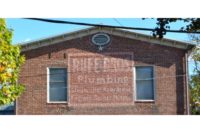Smoke Vents, Doors Help Theater Come Alive

Theater construction projects come with an inherent set of challenges for engineers, architects and construction managers. Besides audience safety, they also must meet the needs of performers, create space for set deployment, and account for directors and producers who demand precise timing and mechanical performance to deliver the best production possible. Unlike the tales told on stage, there is no magic wand to take care of all those concerns.
Architects were especially challenged by the newly-constructed Hale Center Theatre in Sandy City, Utah. The theater cost $80 million, construction began in 2015 and the venue officially opened on September 1, 2017. The new structure replaces a facility in nearby West Valley City, and includes two stages that seat 1,360 guests. Tait Towers, whose portfolio includes work for the Opening Ceremonies at the 2012 Summer Olympics in London, designed the stage. The theater is among the most technologically advanced in the United States, and perhaps the world.
Among the challenges for Layton Construction, the general contractor for the project, were its roofing and flooring needs. Both are essential components to quality theater performance, and with a project of this magnitude, the contractor needed to have the equipment that would make the project sing.
Layton turned to Cannon Sales in Centerville, Utah, for help with roofing and flooring. Cannon is one of Utah’s most experienced resources for commercial construction specialty products. Zack Williams of Cannon suggested BILCO acoustical smoke vents and double-leaf terrazzo doors, all of which proved essential to the project’s construction.
Williams said Layton’s approval for the smoke vents went smoothly. BILCO provided 20 acoustical smoke vents with 24-volt electric thermolatches, which prevent inadvertent opening of the covers that can be caused by wind or building vibrations. The smoke vents feature an STC-46 acoustical sound rating, which guard against noise intrusion, a must-have for the Hale Center. The smoke vents are commonly used in concert halls, theaters and other interior applications that restrict noise from the outside.
They also provide the security of automatic smoke venting. The vents include gas spring operators to open the covers in snow and wind, and have built-in dampers to assure smooth opening and eliminate the possibility of operational, roofing or structural damage.
Williams said several revisions were made during the project’s construction on the size of the doors. “We had to make size revisions because the doors needed to accommodate the theater crew moving stage equipment from below up to the performance floor,’’ Williams said. “We had to change things a couple of times.”
Layton installed two double leaf terrazzo doors, which are designed with a pan cover to accept a variety of flooring materials. Each door is spring balanced to ensure smooth, easy operation upon installation of the flooring material. The door includes an aluminum frame with built-in anchor flange around the perimeter.
The theater’s construction was a complicated and extensive process. Williams said the contractor appreciated finding a supplier with critical components to a puzzle that needed extreme detail. Like the shows on the Hale Center Theatre’s stages, every construction piece had to be perfect. “The thermolatches are integral with the smoke vents,’’ Williams said. “The fact that BILCO makes those and floor doors as well made it easier for the contractor to come to us and kill two birds with one stone.”
Theater President Mark Dietlein and his wife, Sally, the theater’s Vice President, have big dreams for their new facility. “Aida,” a Disney musical that includes music by Elton John, will be the first show at Hale’s 900-seat center stage. It opens in November and will showcase the theater’s technological wonders. The 460-seat Jewel Box theatre opened on September 1.
“Hale Center Theatre does great things with what it has now,’’ said Jeff Beecher, Vice President of Layton Construction in an interview with Deseret News, a daily newspaper in Salt Lake City, Utah. “It’s going to be unbelievable what they’re going to be able to do with this building.”
Looking for a reprint of this article?
From high-res PDFs to custom plaques, order your copy today!






